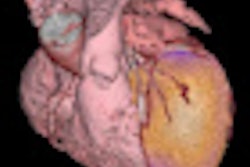Adding functional data from PET to 64-slice coronary CT angiography (CTA) can improve the latter's ability to detect coronary artery disease, overcoming the modality's historic weak point in specificity, according to U.K. researchers.
"We know that coronary CT angiography is limited by the fast motion of the heart, calcification in the coronary arteries, and implanted stents," said lead author Dr. Ashley Groves from University College London in a presentation at last month's SNM meeting in Toronto. "Because of this, the specificity and positive predictive value isn't as good as the high sensitivity and high negative predictive value of the test."
Given those limitations, researchers hypothesized that they could improve coronary CTA's diagnostic accuracy by adding PET data. "We are combining the speed and spatial resolution of CT with the functional imaging that we get from PET," he added.
Groves gave the example of a patient with suspected coronary artery disease and heavy calcification in the arterial tree at the left anterior descending (LAD) artery.
"It is critical that we get the diagnosis correct, if this technique is going to be useful," he said. "However, we know that CT gives rise to artifacts, which means we can not properly examine the lumen. If we now add the PET data, the angst is over and we can immediately see there is no LAD ischemia in the patient."
The researchers retrospectively reviewed 33 patients (28 men and five women; mean age, 61 years) who received PET, PET/CT, and invasive angiography. They used angiography as the gold standard for comparison with the other two modalities, and used a rubidium-based PET protocol for stress imaging and CT for attenuation correction.
An experienced, dual-accredited radiologist/nuclear physician analyzed the combined PET/CT images, and an experienced cardiac CT radiologist reread the CT images without PET.
Among the 33 patients, the invasive angiograms showed that 23 patients had ischemic luminal narrowing of 50% or greater, and PET alone detected 22 of these patients. But CT's lower specificity was reflected in the fact that working alone, it indicated that 25 patients had ischemia. Adding functional data from PET brought that down to 22 patients, Groves said.
CT without PET
CT angiography (without PET data) was concordant with invasive angiography in 31 of the 33 cases (94%). In detecting significant coronary artery lesions (50% or greater), sensitivity was 100%, specificity was 82%, positive predictive value was 92%, and negative predictive value was 100%.
Using PET combined with CTA, the findings were concordant with invasive angiography in 32 of 33 cases (97%). The researchers found that the hybrid technique's sensitivity was 96%, specificity was 100%, positive predictive value was 100%, and negative predictive value was 91%.
"CT performs [with] limited specificity and positive predictive value, which improves with the PET data to perfection, with the cost of some sensitivity," Groves said.
The researchers noted several potential limitations of the study. Invasive angiography is "less than a perfect gold standard," Groves said. "However, it is often used as an accepted reference standard." Also, the study population was limited in keeping with the fact that the project was a feasibility study.
Even with those limitations, the technique of combining PET and 64-slice CT images is "clinically feasible, that PET can aid CT angiography interpretation, and that PET, itself, can give very useful, additional data, such as risk stratification and left ventricle ejection fraction," Groves said.
When questioned about which patients may benefit most from the fusion of PET and CT images, Groves said that two studies are under way -- one in Europe and one in the U.S. -- to try to find an answer.
At the heart of utilizing both PET and CT to detect coronary artery disease is the issue of radiation exposure to a patient, and whether to proceed with a CT scan if the PET image is negative.
By Wayne Forrest
AuntMinnie.com staff writer
July 20, 2009
Related Reading
High-definition PET improves cardiac studies, June 17, 2009
Cedars-Sinai explores PET's future in nuclear cardiology, April 11, 2008
Study correlates CTA to angiography, myocardial perfusion SPECT, May 25, 2007
Rubidium PET/CT shows potential for coronary artery disease diagnosis, March 30, 2007
Copyright © 2009 AuntMinnie.com


















